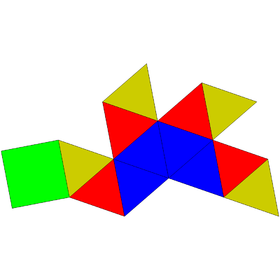| Gyroelongated square pyramid | |
|---|---|
 | |
| Type | Johnson J9 – J10 – J11 |
| Faces | 12 triangles 1 square |
| Edges | 20 |
| Vertices | 9 |
| Vertex configuration | |
| Symmetry group | |
| Properties | convex |
| Net | |
 | |
In geometry, the gyroelongated square pyramid is the Johnson solid that can be constructed by attaching an equilateral square pyramid to a square antiprism. It occurs in the chemistry such as square antiprismatic molecular geometry.
Construction[edit]
The gyroelongated square pyramid is constructed by attaching one equilateral square pyramid to the square antiprism, a process known as the gyroelongation.[1] This construction involves the covering of one of two square faces and replacing them with the four equilateral triangles, so that the resulting polyhedron has twelve equilateral triangles and one square.[2] The convex polyhedron in which all of the faces are regular is the Johnson solid, and the gyroelongated square pyramid is one of them, enumerated as , the tenth Johnson solid.[3]
Properties[edit]
The surface area of a gyroelongated square pyramid with edge length is:[2]
It has the same three-dimensional symmetry group as the square pyramid, the cyclic group of order eight. Its dihedral angle can be derived by calculating the angle of a square pyramid and square antiprism. The dihedral angle of a square pyramid between two adjacent triangles is approximately , and that angle between triangle and square is . The dihedral angle of a square antiprism between two adjacent triangles is , and that between square and triangle is . Therefore, for the attachment of both square pyramid and square antiprism, the dihedral angle between two adjacent triangles is .[4]
Applications[edit]
In stereochemistry, the capped square antiprismatic molecular geometry can be described as the atom cluster of the gyroelongated square pyramid. An example is [LaCl(H
2O)
7]4+
2, a lanthanum(III) complex with a La–La bond.[5]
References[edit]
- ^ Rajwade, A. R. (2001). Convex Polyhedra with Regularity Conditions and Hilbert's Third Problem. Texts and Readings in Mathematics. Hindustan Book Agency. doi:10.1007/978-93-86279-06-4. ISBN 978-93-86279-06-4.
- ^ a b c d Berman, Martin (1971). "Regular-faced convex polyhedra". Journal of the Franklin Institute. 291 (5): 329–352. doi:10.1016/0016-0032(71)90071-8. MR 0290245.
- ^ Uehara, Ryuhei (2020). Introduction to Computational Origami: The World of New Computational Geometry. Springer. p. 62. doi:10.1007/978-981-15-4470-5. ISBN 978-981-15-4470-5. S2CID 220150682.
- ^ Johnson, Norman W. (1966). "Convex polyhedra with regular faces". Canadian Journal of Mathematics. 18: 169–200. doi:10.4153/cjm-1966-021-8. MR 0185507. S2CID 122006114. Zbl 0132.14603.
- ^ Greenwood, Norman N.; Earnshaw, Alan (1997). Chemistry of the Elements (2nd ed.). Butterworth-Heinemann. p. 917. ISBN 978-0-08-037941-8.










